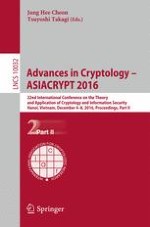The two-volume set LNCS 10031 and LNCS 10032 constitutes the refereed proceedings of the 22nd International Conference on the Theory and Applications of Cryptology and Information Security, ASIACRYPT 2016, held in Hanoi, Vietnam, in December 2016.
The 67 revised full papers and 2 invited talks presented were carefully selected from 240 submissions. They are organized in topical sections on Mathematical Analysis; AES and White-Box; Hash Function; Randomness; Authenticated Encryption; Block Cipher; SCA and Leakage Resilience; Zero Knowledge; Post Quantum Cryptography; Provable Security; Digital Signature; Functional and Homomorphic Cryptography; ABE and IBE; Foundation; Cryptographic Protocol; Multi-Party Computation.
